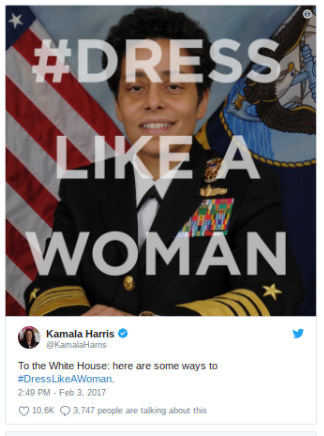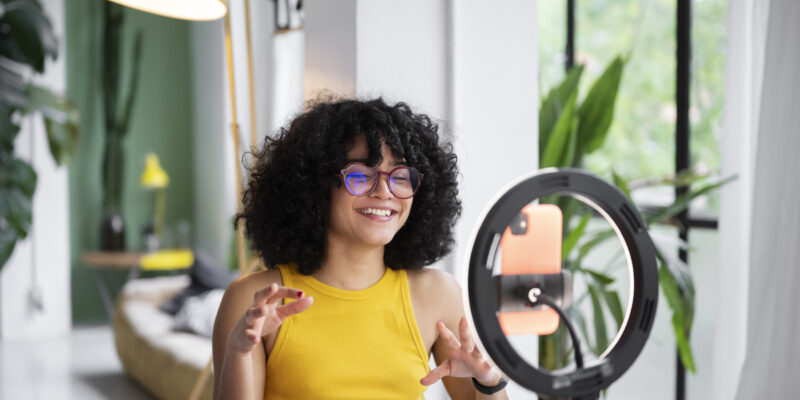
This International Women’s Day, learn about some of the most popular women-led hashtags of the year
The year saw women taking to Twitter and Facebook to expose the harassment, marginalization, and oppression typically suffered in silence. From #MeAt14 to #WOCAffirmation, these cleverly invented hashtags quickly went viral with the help of advocates and supporters. We at Rethink Media encourage the use of hashtags to promote initiatives and spread activism. In celebration of International Women’s Day, we present some examples of ways women changed the #Hashtivism game during the past year.
#MeToo:
Among the most popular hashtags of the year was the call to testimony, #MeToo.
Borrowing from the Me Too movement activist Tarana Burke began in 2007, the phrase experienced a rebirth on Twitter, spearheaded by actress Alyssa Milano in the wake of multiple sexual assault accusations against movie producer Harvey Weinstein. The hashtag was in heavy rotation between October and December of 2017, showing up in Facebook and Twitter posts more than 6 million times.
In a year, it received over 9.8 million mentions, the majority (56%) within the United States. Other users were located in United Kingdom, Canada, Japan, India, Italy, Sweden, France, Australia, and Spain.
#Metoo also had one of the farthest reaches of the year at 30.8 billion users. More than 55% of those who interacted with the hashtag were women.


#MeToo has remained effective and recognizable, rendering it a useful intersectional and cross-promotional tool.
#WOCAffirmation, #WomenBoycottTwitter, and #AmplifyWomen:
Perhaps the most vocal of Weinstein’s accusers, actress Rose McGowan was temporarily suspended from Twitter after using the platform to publicly accuse Weinstein and actor Ben Affleck of sexual misconduct. Many of McGowan’s supporters began circulating hashtag #WomenBoycottTwitter, in solidarity. However, influencers such as comic book author Katie Leth and director Ava Duvernay questioned the effectiveness of the strategy.

An example of respectful debate within the movement, #WOCAffirmation immediately arose in response. During the past year, #WOCAffirmation received more than 174,000 mentions and reached 435 million users, the majority (80%) within the United States. Other users were located in Canada, United Kingdom, India, Australia, Germany, Mexico, Russian Federation, Turkey, and France. More than 66% of those who interacted with the hashtag were women.

#WOCAffirmation can particularly be applied to women in minority ethnic and religious groups.
#AmplifyWomen is another response to #WomenBoycottTwitter. It was first employed by activist and #OscarSoWhite creator April Reign and co-creator of The Daily Show, Lizz Winstead. During the past year, the hashtag received more than 54,000 mentions and reached 163 million users, the majority (81%) within the United States. Other users were located in United Kingdom, Canada, Australia, Ireland, Germany, India, New Zealand, France, and Spain. More than 61% of those who interacted with the hashtag were women.

This post, below, combines #AmplifyWomen with a promotion encouraging ratification of the Equal Rights Amendment to guarantee women equal rights under the law.

Here, the hashtag is used in a post to support building relationships among different racial and ethnic groups:

#DisabledandCute:
Lockport, N.Y., native Keah Brown started the hashtag as a statement about her own physical disability. As a published author, Brown writes often of the intersectionality between disability and race.
Only days after its original publication, Brown’s post received thousands of likes, retweets, and story-shares. Outlets such as Cosmopolitan magazine, Mashable, Teen Vogue, and Yahoo also picked up the story. (Note that several of these outlets are featured in ReThink’s Millennials & New Media Guide. Contact your ReThink media representatives to snag a copy for yourself to find new places to pitch.)
#DisabledandCute had more than 112,000 overwhelmingly positive Twitter mentions in the past year and reached 182 million people, the majority (66%) within the United States. Other users were located in United Kingdom, Canada, Australia, France, South Africa, Germany, Nigeria, Ireland, and India. More than 67% of those who interacted with the hashtag were women.



#MeAt14:
Alabama Senate candidate Roy Moore became infamous in late 2017 for something other than politics for his history of sexual molestation and assault of minors. North Carolina-based attorney, Catherine R. Lawson, coined the hashtag #MeAt14 in response to the indefensible position some of Moore’s supporters took that his teenage victims were capable of consent.

The campaign quickly caught on, with supporters sharing images of their 14-year-old selves and including personalized captions illustrating their naivete at that age. Among them were Alyssa Milano and broadcaster, Katie Couric.


#MeAt14 was incredibly popular over the last year, achieving 85,000 Twitter mentions and reaching 488 million people, the majority (83%) within the United States. Other users were located in Canada, United Kingdom, France, Australia, Japan, Venezuela, Mexico, Spain, and Brazil. Approximately 61% of those who interacted with the hashtag were women.
#DressLikeaWoman:
This clever hashtag amplified protests against President Trump’s reported dress code requirements for women in the White House.
According to Glamour magazine (ahem, another outlet featured in our Millennials & New Media Guide), women employed by the Trump administration felt pressured to wear dresses to work, regardless of their roles.
Academy award-winner Brie Larson was among countless others to use the hashtag in a post that pictured what dressing like a woman meant to her.

Below, a powerful example from Sen. Kamala Harris:

#Dresslikeawoman garnered 457 million Twitter mentions and reached 1.2 billion people, the majority (66%) within the United States. Other users were located in United Kingdom, Canada, Australia, Japan, France, Spain, India, Germany, and Italy. More than 69% of those who interacted with the hashtag were women.
#ShePersisted:
Borrowing from Sen. Mitch McConnell’s criticism of Sen. Elizabeth Warren when the latter refused to be silenced during her testimony against then-candidate for Attorney General, Jeff Sessions’ appointment, women adopted #shepersisted to celebrate “Badass Women from History.”
Activists around the world took the baton in defense of Warren and women who are famous for persisting in the face of great adversity, making this one of the year’s most popular #hashtivism tools.
#ShePersisted garnered 780 million Twitter mentions and reached 2.4 billion people, the majority (89%) within the United States. Other users were located in United Kingdom, Canada, Australia, Mexico, Germany, Ireland, Japan, France, and Italy. Approximately 64% of those who interacted with the hashtag were women.

Above, another profound image employed by Sen. Kamala Harris utilizes text overlay of McConnell’s exact quote over a now-famous picture of a peaceful protester bravely facing a militarized police force.

Sen. Ben Cardin shared an image of women’s suffragist Susan B. Anthony with the #ShePersisted message.
What these posts have in common:
● Simplicity: The hashtags pack a lot of punch in a concise message. The stories behind the phrases are almost immediately clear.
● Exposure: The hashtags are intended to spotlight sexism, ableism, and other unattractive cultural norms, but also frames them as outdated and/or unacceptable. Social psychology tells us that people want to be a part of the winning team. Use that to help frame your campaign.
● Accessibility: Everyone, from lay-people to politicians to celebrities, helped these hashtags go viral. These campaigns did not try to limit who could participate in the conversation. Rather, a variety of voices helped elevate them to higher levels.
● Timeliness: The hashtags these organizers created reacted almost immediately to current events and themes, capturing the immediacy and passion of people’s outrage as they learned about the events.
● Calls to Action: In addition to the hashtags, most posts combined the hashtags with a call to action, providing viewers and participants to channel their energy into doing something. We know from social psychology that providing a call to action makes people feel less hopeless when seeing a campaign like this, making it more likely that they will participate themselves.
Which of these women-driven hashtags over the past year was your favorite? Reach out to us at @Rethink_Media to let us know or to share some that weren’t listed, here!


